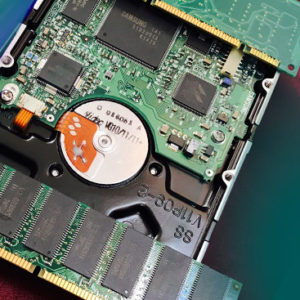Photoresists
 Photoresists are photosensitive materials which after photoimaging and subsequent processing, resist action of certain chemicals in desired areas. They are basically of two types. In negative photoresists, light-exposed areas become less soluble as a result of crosslinking or photopolymerization, leaving behind, after etching and stripping of the resist, opaque features on a clear background. On the other hand, in positive photoresists, the light-exposed areas become more soluble. The photoresists are available in liquid as well as dry film form. They may be solvent or aqueous developing types.
Photoresists are photosensitive materials which after photoimaging and subsequent processing, resist action of certain chemicals in desired areas. They are basically of two types. In negative photoresists, light-exposed areas become less soluble as a result of crosslinking or photopolymerization, leaving behind, after etching and stripping of the resist, opaque features on a clear background. On the other hand, in positive photoresists, the light-exposed areas become more soluble. The photoresists are available in liquid as well as dry film form. They may be solvent or aqueous developing types.
Historically asphalt was used as a photosensitive resist material. In time, it was replaced by dichromated colloids including gelatin, casein etc. The first photoresist based on a photopolymer was invented by Eastman Kodak in late 1940s. This negative photoresist was based on a synthetic photopolymer, polyvinyl cinnamate, in a solvent solution. Crosslinked polymer was insoluble in solvents such as xylene and chlorohydrocarbons which were used as developers after UV exposure. Need for lower viscosity products led to development of negative resists based on cyclized polyisoprene. These photoresists were instrumental in the incredible growth of printed circuit industry and subsequently integrated circuits used in semiconductors.
Pollution concerns led to development of dry film photoresists which grew out of DuPont’s work on photopolymer printing plates. Dry film photoresists are supplied as a sandwich of a photopolymer layer between a polyethylene film and a polyester film. Initially dry film types were solvent-developing but aqueous-processed film resists soon followed and are widely used today for manufacture of printed circuit boards. They are essentially based on acrylic chemistry. In secondary imaging of printed circuit boards, liquid photoimageable products based on epoxy chalcone or acrylated epoxy novolac are employed as solder resists. Cationic polymerized epoxies are employed in thick film resists especially for fabrication of microelectromechanical (MEMS) devices.
At one time, a variety of products were made by photofabrication using photoresists. These included gravure cylinders and rotary screens used in printing, lead frames for semiconductors, photoengravings, nameplates etc. These are now mostly made by electronic methods or have been replaced by newer processes. However, photoresists find significant usage in chemically milled parts (photomachining), decorative glass etc. Semiconductors which used negative resists in large volume have now switched to positive photoresists. Positive photoresists, which decompose upon UV exposure, are predominantly based on diazo compounds formulated with phenolic novolac resins. Newer Deep-UV resists used in microelectronics are based on novolac isomer, polyhydroxystyrene and its copolymers. Technology of positive resists is not based on photopolymerzation or photocrosslinking and hence they are not considered as photopolymer products.
MANUFACTURERS:
Liquid Photoresists:
- Electra
- HTP HiTech Photopolymere
- AZ Products (Merck)
- Fujifilm Holdings
- JSR Micro
- Tokyo Ohka Kogyo
- Huntsman Advanced Materials
- Sumitomo
- Taiyo
- Advanced Coatings International
- Micro Resist Technology
- Kayaku Advanced Materials
- Chang Chun Group
- KemLab
- Nagase Chemtex
- ShinEtsu
Dry Film Photoresists
- DuPont
- Asahi Kasei
- Chang Chun Group
- Showa Denko Materials
- Eternal Chemical
- Kolon Industries
- Taiyo
- DJ Microlaminates
- Nagase Chemtex

